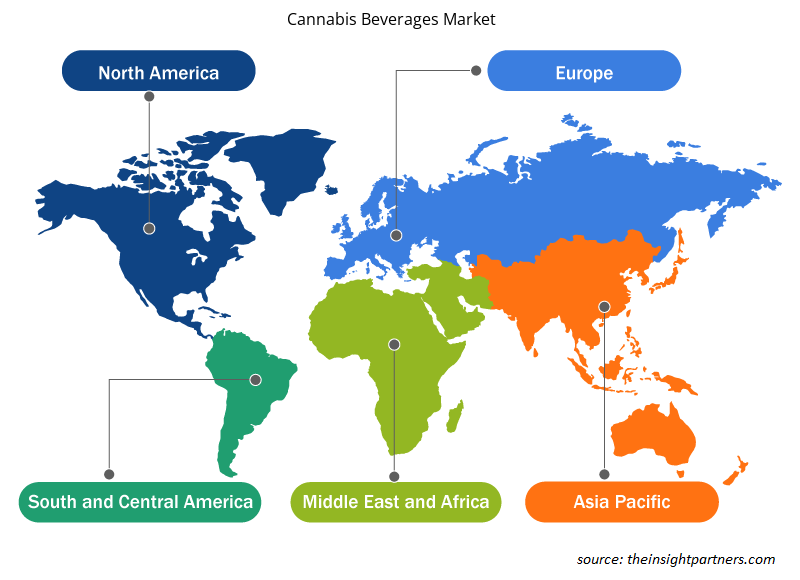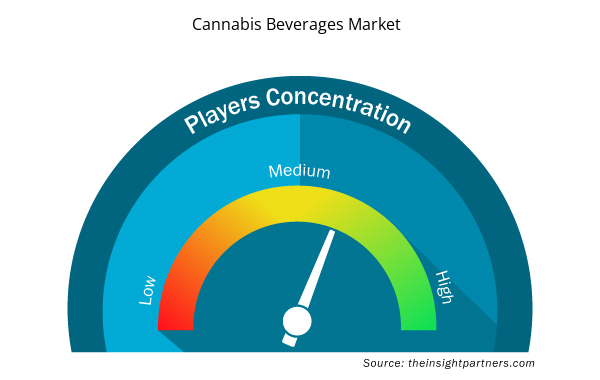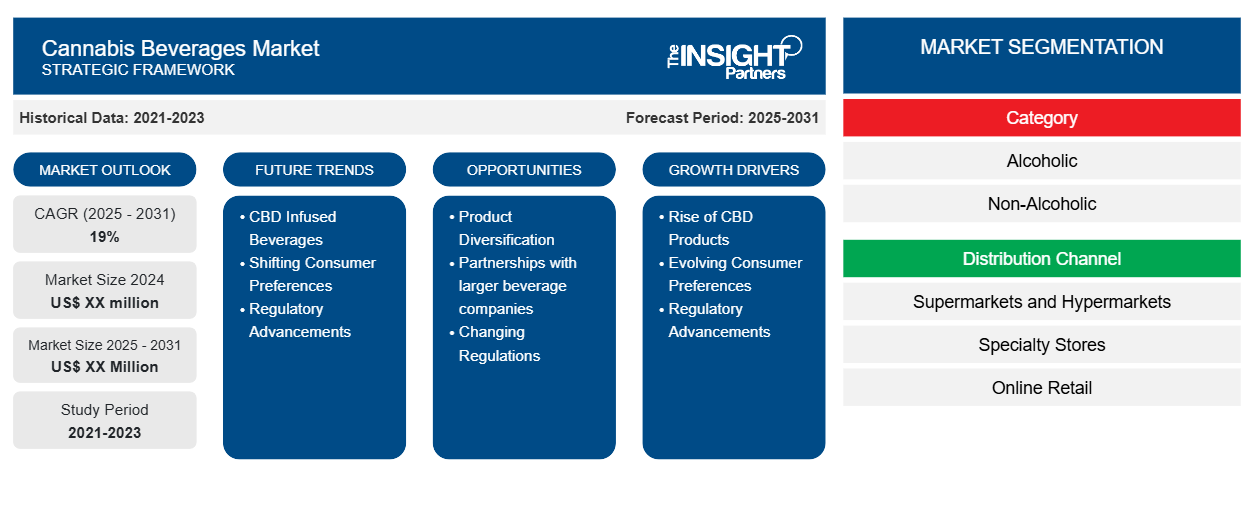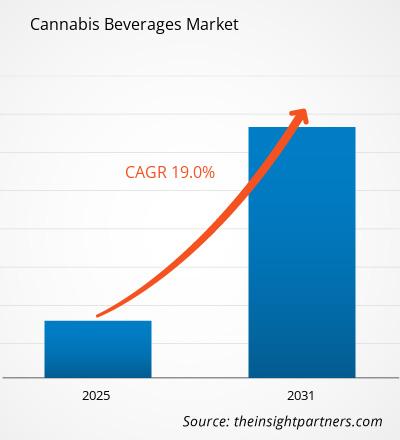Si prevede che il mercato delle bevande alla cannabis registrerà un CAGR del 19% dal 2023 al 2031, con una dimensione di mercato in espansione da XX milioni di dollari nel 2023 a XX milioni di dollari entro il 2031.
Il rapporto sul mercato globale delle bevande alla cannabis è segmentato per tipo, canale di distribuzione e regione, offrendo al contempo approfondimenti aggiuntivi sui mercati regionali e sui principali paesi. Aiuta le parti interessate a comprendere il valore potenziale del mercato globale delle bevande alla cannabis e a valutare accuratamente i parametri chiave associati al mercato e ai suoi settori sottostanti. Fornisce stime di dimensioni e previsioni in termini di valore (dollari USA) per il mercato complessivo delle bevande alla cannabis, tipo, canale di distribuzione e mercati regionali.
Scopo del rapporto
Il report Cannabis Beverages Market di The Insight Partners mira a descrivere il panorama attuale e la crescita futura, i principali fattori trainanti, le sfide e le opportunità. Ciò fornirà spunti a vari stakeholder aziendali, come:
- Fornitori/produttori di tecnologia: per comprendere le dinamiche di mercato in evoluzione e conoscere le potenziali opportunità di crescita, consentendo loro di prendere decisioni strategiche informate.
- Investitori: condurre un'analisi completa delle tendenze in merito al tasso di crescita del mercato, alle proiezioni finanziarie del mercato e alle opportunità esistenti lungo la catena del valore.
- Enti di regolamentazione: regolamentano le politiche e le attività di controllo sul mercato allo scopo di ridurre al minimo gli abusi, preservare la fiducia degli investitori e sostenere l'integrità e la stabilità del mercato.
Segmentazione del mercato delle bevande alla cannabis
Categoria
- Alcolico
- Analcolico
Canale di distribuzione
- Supermercati e Ipermercati
- Negozi specializzati
- Vendita al dettaglio online
Personalizza questo report in base alle tue esigenze
Riceverai la personalizzazione gratuita di qualsiasi report, comprese parti di questo report, o analisi a livello nazionale, pacchetto dati Excel, oltre a usufruire di grandi offerte e sconti per start-up e università
- Scopri le principali tendenze di mercato in questo rapporto.Questo campione GRATUITO includerà analisi di dati che spaziano dalle tendenze di mercato alle stime e alle previsioni.
Fattori trainanti della crescita del mercato delle bevande alla cannabis
- Ascesa dei prodotti al CBD: le bevande infuse di cannabidiolo (CBD) stanno guadagnando una notevole popolarità grazie alla popolarità del CBD per i suoi benefici per la salute non psicoattivi. Ciò sta espandendo il mercato attraendo consumatori attenti alla salute che cercano i benefici terapeutici della cannabis senza l'effetto sballo.
- Evoluzione delle preferenze dei consumatori: le bevande alla cannabis stanno diventando sempre più popolari come opzione comoda e discreta per il consumo di cannabis. Con la crescente tendenza dei prodotti da asporto e monodose, le bevande alla cannabis soddisfano la domanda di opzioni portatili e facili da consumare.
- Progressi normativi: man mano che le leggi sulla cannabis continuano a evolversi e i governi implementano quadri normativi più chiari per i prodotti a base di cannabis, il mercato delle bevande alla cannabis sta acquisendo maggiore legittimità. La chiarezza normativa garantisce che i prodotti soddisfino gli standard di sicurezza e possano essere commercializzati più facilmente.
Tendenze future del mercato delle bevande alla cannabis
- Bevande infuse di CBD: le bevande infuse di CBD stanno guadagnando importanza Con la popolarità del CBD con i suoi benefici per la salute non psicoattivi, le bevande infuse di CBD stanno guadagnando importanza. Ciò sta espandendo il mercato per attrarre consumatori attenti alla salute che cercano gli effetti terapeutici della cannabis senza l'effetto psicoattivo.
- Cambiamento delle preferenze dei consumatori: le bevande a base di cannabis stanno diventando sempre più un modo comodo e discreto per consumare cannabis. Le bevande alla cannabis si adattano alla crescente tendenza dei prodotti da asporto e monodose. Le bevande alla cannabis soddisfano questa domanda perché sono portatili e facili da consumare.
- Progressi normativi: poiché le leggi sulla cannabis continuano a evolversi e i governi implementano quadri normativi più chiari per i prodotti a base di cannabis, il mercato delle bevande alla cannabis sta guadagnando maggiore legittimità. La chiarezza normativa garantisce che i prodotti soddisfino gli standard di sicurezza
Opportunità di mercato per le bevande alla cannabis
- Diversificazione dei prodotti: si prevede che il mercato delle bevande alla cannabis avrà una rapida crescita tra il 2021 e il 2031 a causa dell'evoluzione delle abitudini di consumo e della crescente legalizzazione con sviluppi di prodotti innovativi. Con la crescente accettazione delle bevande alla cannabis, le opportunità risiedono in questo segmento, un principale entrante nel mercato delle bevande, per i consumatori orientati alla salute che desiderano un'alternativa al consumo di alcol.
- Partnership con aziende di bevande più grandi: le partnership con aziende di bevande più grandi potrebbero anche essere un modo per estendere la distribuzione e il marketing. Enfatizzare l'artigianalità in sapori unici, concentrandosi su ingredienti biologici o di provenienza locale, può aiutare a comandare un segmento di mercato premium.
- Regolamenti in evoluzione: i regolamenti cambiano e continuano a evolversi; le aziende che dimostrano conformità e trasparenza generano fiducia nei consumatori, il che contribuirà ulteriormente alla spinta della penetrazione del mercato.
Nel complesso, il mercato delle bevande alla cannabis è un panorama dinamico per l'innovazione, la differenziazione del marchio e la collaborazione strategica che renderà il settore un'arena entusiasmante per aziende nuove ed esistenti nel prossimo decennio.
Approfondimenti regionali sul mercato delle bevande alla cannabis
Le tendenze regionali e i fattori che influenzano il mercato delle bevande alla cannabis durante il periodo di previsione sono stati ampiamente spiegati dagli analisti di Insight Partners. Questa sezione discute anche i segmenti e la geografia del mercato delle bevande alla cannabis in Nord America, Europa, Asia Pacifico, Medio Oriente e Africa e America centrale e meridionale.

- Ottieni i dati specifici regionali per il mercato delle bevande alla cannabis
Ambito del rapporto sul mercato delle bevande alla cannabis
| Attributo del report | Dettagli |
|---|---|
| Dimensioni del mercato nel 2023 | XX milioni di dollari USA |
| Dimensioni del mercato entro il 2031 | XX milioni di dollari USA |
| CAGR globale (2023-2031) | 19% |
| Dati storici | 2021-2022 |
| Periodo di previsione | 2024-2031 |
| Segmenti coperti | Per categoria
|
| Regioni e Paesi coperti | America del Nord
|
| Leader di mercato e profili aziendali chiave |
|
Densità dei player del mercato delle bevande alla cannabis: comprendere il suo impatto sulle dinamiche aziendali
Il mercato delle bevande alla cannabis sta crescendo rapidamente, spinto dalla crescente domanda degli utenti finali dovuta a fattori quali l'evoluzione delle preferenze dei consumatori, i progressi tecnologici e una maggiore consapevolezza dei benefici del prodotto. Con l'aumento della domanda, le aziende stanno ampliando le loro offerte, innovando per soddisfare le esigenze dei consumatori e capitalizzando sulle tendenze emergenti, il che alimenta ulteriormente la crescita del mercato.
La densità degli operatori di mercato si riferisce alla distribuzione di aziende o società che operano in un particolare mercato o settore. Indica quanti concorrenti (operatori di mercato) sono presenti in un dato spazio di mercato in relazione alle sue dimensioni o al valore di mercato totale.
Le principali aziende che operano nel mercato delle bevande alla cannabis sono:
- Società a responsabilità limitata
- Cannabis Aurora
- Società a responsabilità limitata
- Società di crescita del baldacchino
- Cronos Group Inc.
Disclaimer : le aziende elencate sopra non sono classificate secondo un ordine particolare.

- Ottieni una panoramica dei principali attori del mercato delle bevande alla cannabis
Punti di forza chiave
- Copertura completa: il rapporto esamina in modo completo i prodotti, i servizi, le tipologie e gli utenti finali del mercato delle bevande alla cannabis, offrendo una panoramica olistica.
- Analisi degli esperti: il rapporto è compilato sulla base della conoscenza approfondita di esperti e analisti del settore.
- Informazioni aggiornate: il rapporto garantisce la pertinenza aziendale grazie alla copertura di informazioni recenti e tendenze nei dati.
- Opzioni di personalizzazione: questo report può essere personalizzato per soddisfare le esigenze specifiche del cliente e adattarsi in modo appropriato alle strategie aziendali.
Il rapporto di ricerca sul mercato delle bevande alla cannabis può, quindi, aiutare a guidare il percorso di decodificazione e comprensione dello scenario del settore e delle prospettive di crescita. Sebbene possano esserci alcune preoccupazioni valide, i vantaggi complessivi di questo rapporto tendono a superare gli svantaggi.
- Analisi storica (2 anni), anno base, previsione (7 anni) con CAGR
- Analisi PEST e SWOT
- Valore/volume delle dimensioni del mercato - Globale, regionale, nazionale
- Industria e panorama competitivo
- Set di dati Excel


- Excimer & Femtosecond Ophthalmic Lasers Market
- Pharmacovigilance and Drug Safety Software Market
- Customer Care BPO Market
- Public Key Infrastructure Market
- Truck Refrigeration Market
- Machine Condition Monitoring Market
- Airport Runway FOD Detection Systems Market
- Educational Furniture Market
- Broth Market
- Rare Neurological Disease Treatment Market

Report Coverage
Revenue forecast, Company Analysis, Industry landscape, Growth factors, and Trends

Segment Covered
This text is related
to segments covered.

Regional Scope
North America, Europe, Asia Pacific, Middle East & Africa, South & Central America

Country Scope
This text is related
to country scope.
Domande frequenti
The report can be delivered in PDF/PPT format; we can also share excel dataset based on the request.
Some of the customization options available based on request are additional 3-5 company profiles and country-specific analysis of 3-5 countries of your choice. Customizations are to be requested/discussed before making final order confirmation, as our team would review the same and check the feasibility.
The cannabis beverage market will continue to grow as consumers become more health-conscious and seek to imbibe more responsibly and with fewer calories. As regulations continue to soften, we expect companies to get creative with a host of new cannabis drinks and to curry favour with consumers who are increasingly eager to be more eco-friendly while demanding more transparency from brands, at least in part by selling directly.
Leading companies in this market are - Aphria Inc, Aurora Cannabis, CannTrust Holdings Inc, Canopy Growth Corporation, Cronos Group Inc, Koios Beverage Corporation, New Age Beverages Corporation, Phivida Holdings Inc, The Alkaline Water Company
The market is expected to register a CAGR of 19% during 2021-2031
The increasing acceptance of marijuana as well as its health benefits is altering consumer perception. The demand for different modes of consuming cannabis is rising especially the health-conscious purchasers of other edible products demand healthy, low-calorie natural products which will further drive the growth of the market.
Trends and growth analysis reports related to Food and Beverages : READ MORE..
1. Aphria Inc.
2. Aurora Cannabis
3. CannTrust Holdings Inc.
4. Canopy Growth Corporation
5. Cronos Group Inc.
6. Koios Beverage Corporation
7. New Age Beverages Corporation
8. Phivida Holdings Inc
9. The Alkaline Water Company
10. VIVO Cannabis Inc.
The Insight Partners performs research in 4 major stages: Data Collection & Secondary Research, Primary Research, Data Analysis and Data Triangulation & Final Review.
- Data Collection and Secondary Research:
As a market research and consulting firm operating from a decade, we have published and advised several client across the globe. First step for any study will start with an assessment of currently available data and insights from existing reports. Further, historical and current market information is collected from Investor Presentations, Annual Reports, SEC Filings, etc., and other information related to company’s performance and market positioning are gathered from Paid Databases (Factiva, Hoovers, and Reuters) and various other publications available in public domain.
Several associations trade associates, technical forums, institutes, societies and organization are accessed to gain technical as well as market related insights through their publications such as research papers, blogs and press releases related to the studies are referred to get cues about the market. Further, white papers, journals, magazines, and other news articles published in last 3 years are scrutinized and analyzed to understand the current market trends.
- Primary Research:
The primarily interview analysis comprise of data obtained from industry participants interview and answers to survey questions gathered by in-house primary team.
For primary research, interviews are conducted with industry experts/CEOs/Marketing Managers/VPs/Subject Matter Experts from both demand and supply side to get a 360-degree view of the market. The primary team conducts several interviews based on the complexity of the markets to understand the various market trends and dynamics which makes research more credible and precise.
A typical research interview fulfils the following functions:
- Provides first-hand information on the market size, market trends, growth trends, competitive landscape, and outlook
- Validates and strengthens in-house secondary research findings
- Develops the analysis team’s expertise and market understanding
Primary research involves email interactions and telephone interviews for each market, category, segment, and sub-segment across geographies. The participants who typically take part in such a process include, but are not limited to:
- Industry participants: VPs, business development managers, market intelligence managers and national sales managers
- Outside experts: Valuation experts, research analysts and key opinion leaders specializing in the electronics and semiconductor industry.
Below is the breakup of our primary respondents by company, designation, and region:

Once we receive the confirmation from primary research sources or primary respondents, we finalize the base year market estimation and forecast the data as per the macroeconomic and microeconomic factors assessed during data collection.
- Data Analysis:
Once data is validated through both secondary as well as primary respondents, we finalize the market estimations by hypothesis formulation and factor analysis at regional and country level.
- Macro-Economic Factor Analysis:
We analyse macroeconomic indicators such the gross domestic product (GDP), increase in the demand for goods and services across industries, technological advancement, regional economic growth, governmental policies, the influence of COVID-19, PEST analysis, and other aspects. This analysis aids in setting benchmarks for various nations/regions and approximating market splits. Additionally, the general trend of the aforementioned components aid in determining the market's development possibilities.
- Country Level Data:
Various factors that are especially aligned to the country are taken into account to determine the market size for a certain area and country, including the presence of vendors, such as headquarters and offices, the country's GDP, demand patterns, and industry growth. To comprehend the market dynamics for the nation, a number of growth variables, inhibitors, application areas, and current market trends are researched. The aforementioned elements aid in determining the country's overall market's growth potential.
- Company Profile:
The “Table of Contents” is formulated by listing and analyzing more than 25 - 30 companies operating in the market ecosystem across geographies. However, we profile only 10 companies as a standard practice in our syndicate reports. These 10 companies comprise leading, emerging, and regional players. Nonetheless, our analysis is not restricted to the 10 listed companies, we also analyze other companies present in the market to develop a holistic view and understand the prevailing trends. The “Company Profiles” section in the report covers key facts, business description, products & services, financial information, SWOT analysis, and key developments. The financial information presented is extracted from the annual reports and official documents of the publicly listed companies. Upon collecting the information for the sections of respective companies, we verify them via various primary sources and then compile the data in respective company profiles. The company level information helps us in deriving the base number as well as in forecasting the market size.
- Developing Base Number:
Aggregation of sales statistics (2020-2022) and macro-economic factor, and other secondary and primary research insights are utilized to arrive at base number and related market shares for 2022. The data gaps are identified in this step and relevant market data is analyzed, collected from paid primary interviews or databases. On finalizing the base year market size, forecasts are developed on the basis of macro-economic, industry and market growth factors and company level analysis.
- Data Triangulation and Final Review:
The market findings and base year market size calculations are validated from supply as well as demand side. Demand side validations are based on macro-economic factor analysis and benchmarks for respective regions and countries. In case of supply side validations, revenues of major companies are estimated (in case not available) based on industry benchmark, approximate number of employees, product portfolio, and primary interviews revenues are gathered. Further revenue from target product/service segment is assessed to avoid overshooting of market statistics. In case of heavy deviations between supply and demand side values, all thes steps are repeated to achieve synchronization.
We follow an iterative model, wherein we share our research findings with Subject Matter Experts (SME’s) and Key Opinion Leaders (KOLs) until consensus view of the market is not formulated – this model negates any drastic deviation in the opinions of experts. Only validated and universally acceptable research findings are quoted in our reports.
We have important check points that we use to validate our research findings – which we call – data triangulation, where we validate the information, we generate from secondary sources with primary interviews and then we re-validate with our internal data bases and Subject matter experts. This comprehensive model enables us to deliver high quality, reliable data in shortest possible time.


 Ottieni un campione gratuito per questo repot
Ottieni un campione gratuito per questo repot